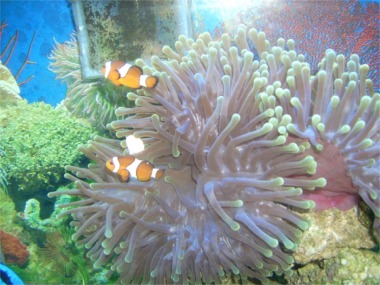|
|
||
|
|
|
|
|
|
||
|
Within each anemone, there is a monogamous mating pair. Only the two
largest fish, the male and female, mate, while all others are sexually
inactive. The process of reproduction begins with the male courting the
female fish. This courting is done through a process of extending his fins
towards her, and then biting and chasing her around the
anemone. Oftentimes, the male becomes very aggressive during this
spawning period. Once the male has chased the female fish to the nest,
the female will make several passes over the nest before releasing her
eggs. A female clownfish can release a clutch size ranging from 100
eggs, up to 1,000 eggs, depending on her age and size.
Amphiprion ocellaris eggs are orange and relatively small
in size. With the eggs released, the male then passes over the
nest and
fertilizes them. Next, the eggs are attached to a substrate, which
can be either a rock or
some coral beneath the anemone’s oral discs, or in some extreme cases, debris around the
host. Once the eggs are attached, the male become their prime
caregiver. The males job is to fan the eggs to increase the amount
of oxygen interacting with them, as well as to eat any unfertilized or
damaged ones in order to keep the nesting site clean. The hatching
period for the eggs often depends on the temperature of the water. On
average, however, the eggs hatch between six and eight days. Once the
eggs have hatched, the pelagic larvae are independent from their
parents. This larval stage lasts anywhere from 14 to 21 days. During
this time, the young clownfish can often be found to school in other reef fish
hatcheries, which provides protection to the fish without the need for a
host anemone. After this period, the fish undergo a phase change in which
they become benthic juveniles. It is then that they begin to search for
a host sea anemone to live in. (See also
Habitat and Adaptations). Amphiprion ocellaris are
mostly sedentary creatures following this settlement and only migrate between hosts if
they are close together. A clownfish can survive in the wild up to
ten years. |
||
